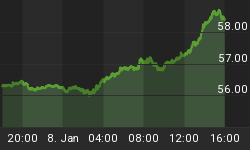
U.S. Treasury Securities are no longer risk-free. This news comes after Standard and Poor's cut the triple-A rating it has awarded the U.S. since 1941 (Moody's has been in the AAA camp since 1917). Given the U.S.'s status as the world's reserve currency printer - not to mention the safe haven flows arriving in the U.S. due to the recent upheaval in Euroland - the immediate impact of the downgrade is highly uncertain. However, what can be said is that should Moody's or Fitch also cut, capital may be required to exit U.S. debt due to restrictive ownership covenants. This ominous prospect could quickly come into play should another financial crisis arise and/or the U.S. economy slip back into recession. After all, Moody's warned last week that it may cut if lawmakers do not enact larger debt reduction plans (an increasingly difficult undertaking with the markets and economy weakening), and Fitch is set to complete its U.S. ratings review by the end of August.
Rather than focus intently on the difficult steps required to maintain its triple-A rating, policy makers, regulators, and Wall Street may now be in panic mode - trying to covertly rid the marketplace of pesky AAA covenants and/or take the rogue rating agency that is Standard and Poor's down a notch. Perhaps highlighting this trend - or that of ignoring the message in favor of scheming behind closed doors - an array of conflicting/interesting reports crossed shortly before and after yesterday's ratings cut.
S&P said to back away from U.S. downgrade MW
Standard & Poor's has reportedly backed off a plan to strip the U.S government of its prized triple-A debt rating Friday after White House officials challenged the analysis...
BL: The U.S. immediately lashed out at S&P, with a Treasury Department spokesman saying the firm's analysis contains a $2 trillion error. The spokesman, who asked not to be identified by name, didn't elaborate, saying the mistake speaks for itself. Dow Jones
CNN: "This is a facts-be-damned decision," the senior official said. "Their analysis was way off, but they wouldn't budge."..."These guys make Congress look good," the official said of S&P
Obama officials attack S&P's credibility after downgrade Reuters
Suffice to say, the story being told threatens to become more about the suspicious actions of S&P than about the historic U.S. ratings cut. As for the NYT, they went a completely different route: using "A spokesman for the Federal Reserve" and dutifully noting that closed markets do not trade:
"The announcement came after markets closed for the weekend, but there was no evidence of any immediate disruption."
As shocking as S&P's mathematical mistake is at this stage of the game, what should be remembered is that the major rating agencies will (allegedly) rate crap triple-A for a price and they will always be late downgrading this crap once it blows-up. But what the major U.S. rating agencies do not tend to do, unless the issue they are covering fails to pay-up, is downgrade for no reason. Realizing they would face the wrath of many different regulatory and policy making powers that be, Standard and Poor's nonetheless became the first major NRSRO to cut the U.S.'s AAA. Now policy makers are torn between seeking retribution against S&P or trying to appease the demands of Fitch and Moody's. If the debt ceiling debacle is any indication, don't count on a successful multitask.
Standard & Poor's Clarifies Assumption Used On Discretionary Spending Growth PR
















